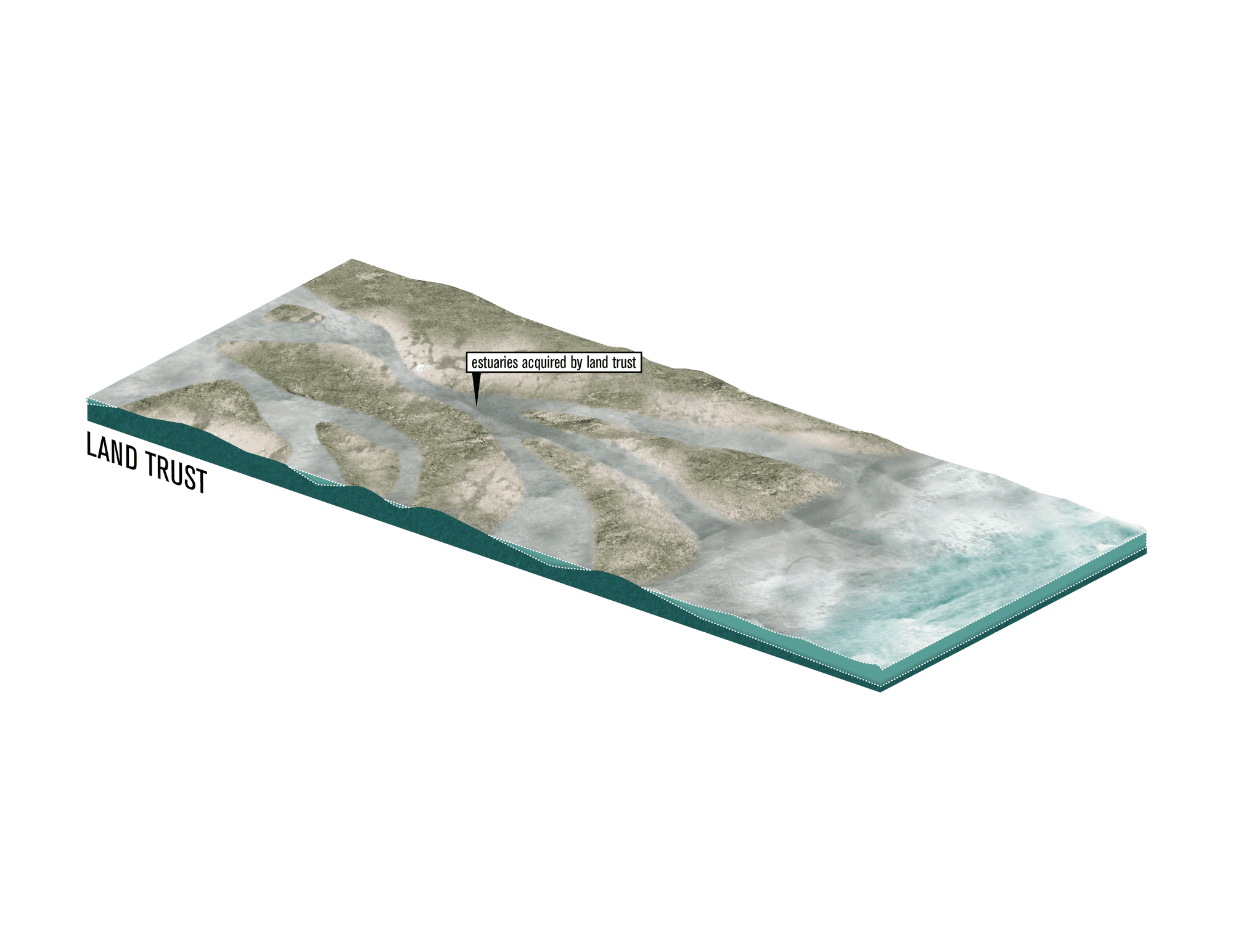Adaptation Strategy: Land Trust
A land trust is a non-profit private organization created for the purpose of environmental conservation. The trust acquires lands that it intends to protect for some natural or historical purpose through purchase, donation, covenant, or lease.1, 2 Conservation objectives may be broad in scope, i.e., they may cover serval environmental issues and goals.3 However, in some instances a land trust may be established to combat the effects of a specific issue such as sea-level rise. For example, the Hawaiian Island Land Trust was established to protect sand dunes from SLR 12 The trust focuses on restoring coastal vegetation as an adaptation strategy. In British Columbia Canada, there are 34 land trust organizations. Collectively, these trusts have conserved more than 1 million acres of land. 13
How it works
Types of land trust
- Community land trusts (CLT) are not-for-profit organizations where membership is open to any resident of the geographical region or bioregion where the trust is located. The purpose of a CLT is to create a democratic institution to hold land and to retain the use-value of the land for the benefit of the community.
- Conservation land trusts are created to protect property from future development. This might involve protecting greenfield sites or reclaiming and restoring brownfield sites 14
- Coastal land trusts help to conserve coastal shorelines and landscapes and cultural values. Some coastal land trusts have been established to combat the effects of climate change. 15, 16
Benefits
- Can serve as a complement to standard land use regulations within a given planning framework.
- More likely to be effective conservation measure when used in conjunction with other approaches to land reform 14
- Private donations of lands allow for the protection of ecological assets at minimum cost to the state 17
- Helps to foster land stewardship for community-based uses and benefits
Challenges
- It may be difficult to obtain resources to acquire, restore, and manage environmentally significant lands
- May require negotiating with multiple landowners to acquire conservation easements 15
- There might be legal challenges related to the incompatibility of land use such as timber harvesting and mining. For example, subsurface rights to resources may not be included in a land trust donation 18
Example projects
Hawaiian Island Land Trust
Hawaii, USA
The Hawaiian Island Land Trust (HILT) was established to protect ecologically sensitive landscapes. In 2004, HILT acquired the ownership of the 277 acres Waihe’e Coastal Dunes and Wetland Refuge.4 The program was established to restore and enhance critical ecosystems while preserving historical and cultural resources.5, 6 These ecosystems will be inundated in the future by sea-level rise. Thus, the program aims to restore the landscape to what it was in the past.7 With the help of volunteers, over 70% of native species have returned to the landscape.8
Englishman River Estuary
Parksville BC, Canada
In 1992, the Nature Trust of B.C purchased 76.7-hectare Englishman River Estuary with a five-year plan to improve the habitat for fish and wildlife.9 Estuaries are ecologically sensitive landscapes that are important for the stabilization of coastal areas. Estuaries also act as natural buffers in the event of a storm surge. Since the 1930s, the construction of dikes, roads, and residential development have dramatically impacted natural tidal and river processes.10 However, a plan to remove man-made structures such as the abandoned roadway helped to restore natural ecological processes.11 Having a healthy estuary helps to reduce the severity of inland flooding and the impact of tidal waves.
Citations
-
1.
↑
The Arlington Group Planning Architecture Inc., et al. Sea Level Rise Adaptation Primer. pp. 55. https://www2.gov.bc.ca/assets/gov/environment/climate-change/adaptation/resources/slr-primer.pdf
-
2.
↑
Ibid, 56.
-
3.
↑
Ibid, 56.
-
4.
↑
“The Hawaiian Islands Land Trust - Waihe'e Coastal Dunes and Wetlands Refuge.” Conservation in a Changing Climate, https://climatechange.lta.org/case-study/hilt_waihee_restoration/.
-
5.
↑
Ibid.
-
6.
↑
Ibid.
-
7.
↑
Ibid.
-
8.
↑
Ibid.
-
9.
↑
“Restoration Work Begins on the Englishman River Estuary.” The Nature Trust of British Columbia, 15 Mar. 2018, https://www.naturetrust.bc.ca/news/restoration-work-begins-englishman-river-estuary.
-
10.
↑
Ibid.
-
11.
↑
Ibid.
-
12.
↑
Land Trust Alliance. (2014). The Waihe’e Coastal Dunes and Wetlands Refuge: full case study. Retrieved from http://www.landtrustalliance.org/climate-change-toolkit/inspire/case-studies/hawaiian-islands
-
13.
↑
McNair & Harrington. (2016). Land Trusts in BC – The Importance of People Protecting Places. The land conservancy of British Columbia. https://conservancy.bc.ca/2010/09/land-trusts-in-bc-the-importance-of-people-protecting-places/
-
14.
↑
Campbell, M. C., & Salus, D. A. (2003). Community and conservation land trusts as unlikely partners. The case of Troy Gardens, Madison, Wisconsin. Land Use Policy, 20(2), 169-180.
-
15.
↑
Bonar, D. (2021). Maui Coastal Land Trust. Coastal adaptation knowledge exchange. https://www.cakex.org/community/directory/organizations/maui-coastal-land-trust
-
16.
↑
Witt, S and Swann, R. (1995). LAND: CHALLENGE AND OPPORTUNITYhttps://centerforneweconomics.org/publications/land-challenge-and-opportunity/
-
17.
↑
Myhr, R. O. (1987). Private Coastline Conservation Management: The Land Trust in the San Juan Islands, Washington. In Coastal Zone'87 (pp. 3266-3273). ASCE.
- 18. ↑
- i1. ↑
-
i2.
↑
The Englishman River Estuary. https://www.naturetrust.bc.ca/wp-content/uploads/2017/06/englishman-river-aerial-shot-2017-1024x685.jpg.
